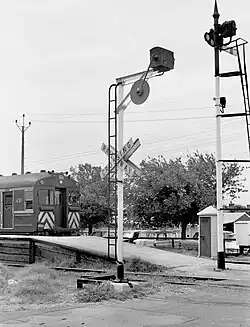Holdens railway station
Holdens railway station Woodville, South Australia | |
|---|---|
| General information | |
| Location | Rowley Terrace Woodville |
| Line(s) | Grange Line |
| Distance | 7.8 km (4.8 mi) from Adelaide |
| Platforms | 3 (island plus single platform for Holden's employees) |
| Tracks | 3 |
| Construction | |
| Structure type | 2 small shelters |
| History | |
| Opened | 1928 |
| Closed | 1992 |
Holdens railway station (originally Holden's) was opened in 1928 on the Henley Beach railway line (now shortened as the Grange line) in the western Adelaide suburb of Woodville, 7.8 kilometres (4.8 miles) from Adelaide station. Only 200 metres (220 yards) from the junction on to the Henley Beach line, it served the site on which General Motors-Holden's Ltd manufactured motor vehicles. The factory and station closed in 1992, and the site was subsequently redeveloped, mainly with large retail outlets.
History
.jpg)
Holden's Motor Body Builders Ltd had operated since 1917 from 400 King William Street, at the southern end of Adelaide's central business district. Expanding business prompted the company to build a new site at Woodville in 1923.[1] Occupying 16 hectares (40 acres), it was bounded by the Port railway line and the 7.8-kilometre (4.8-mile) Henley Beach branch line. A 600-metre (660-yard) siding within the works joined the branch line near two passenger platforms; trains conveyed sheet steel in and automotive bodies out. From 1924, the factory's output increased further when it began supplying car bodies for the US General Motors in Australia, and later providing bodies to fit on to imported chassis. In 1931, General Motors–Holden's Ltd (GMH) was incorporated to run a then very successful business. In turn, this provided substantial railway traffic.[2]: 1–1301
Before 1955, when double-ended railcars operated the passenger services, a locomotive-hauled train would proceed past Holden's to Albert Park or Hendon, further along the branch line. There the locomotive would run around the train via a passing loop before returning to Holden's. In earlier times some trains from Adelaide ran only as far as Holden's, before reversing to Woodville to continue along the Port line to Semaphore.[2]: 1–1313
With the outbreak of war in 1939, manufacturing production throughout Australia increased greatly by mobilising resources and manpower, materials and productive capacity. Manufacturing capacity at Holden's was expanded and redirected to the war effort.[2]: 1–1309 Reflecting the large increase in the workforce, a third platform was erected for commuting workers during the war. This configuration supplemented the existing island platform, which was straddled by two tracks that merged to single track a short distance beyond the station.[3][4]
Freight and passenger traffic declined after the war. In 1955, out of 29 return weekday movements on the Henley Beach line, four were to Holden's at change-of-shift times.
In 1963, General Motors–Holden's opened a new plant at Elizabeth and as a consequence traffic to the Woodville factory was further reduced. In 1992, both factories closed; the station and siding were subsequently removed.[5]

References
- ^ "From saddlery in 1859, Adelaide's Holden family firm grabs 20th Century chance to make bodies for US car giants". Adelaide AZ. 2024. Retrieved 13 August 2025.
- ^ a b c Barrington, Rodney (2022). "When Henley Beach had a railway". Proceedings of the 2022 Convention. Modelling the Railways of South Australia. Adelaide.
- ^ South Australian Railways (1941). "D42/9: Woodville – extension of earth-filled platform at Holden's" (Document). Adelaide: South Australian Railways (via National Railway Museum, Port Adelaide).
- ^ South Australian Railways (1948). "D48/50: Holden's – permanent way alterations" (Document). Adelaide: South Australian Railways (via National Railway Museum, Port Adelaide).
- ^ Quinlan, Howard; Newland, John R. (2000). Australian railway routes 1854–2000. Redfern, New South Wales: Australian Railway Historical Society, New South Wales Division. p. 54. ISBN 0909650497.